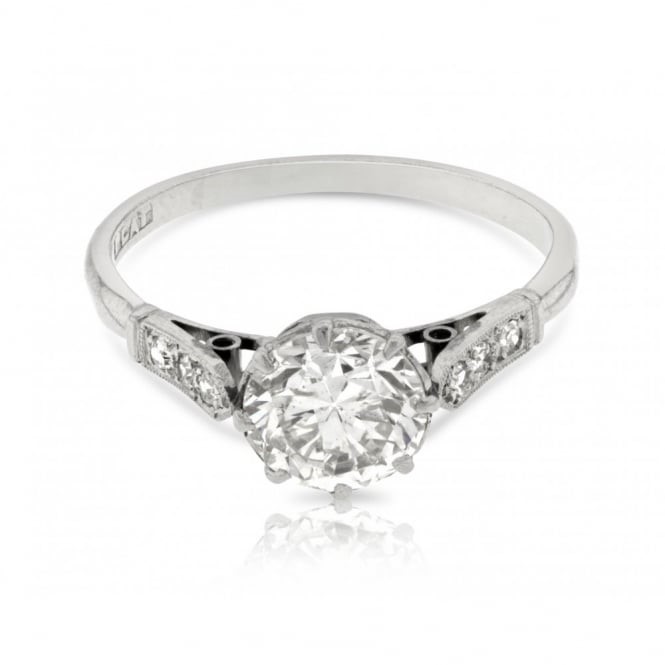The guide to diamonds | Antique Collecting Magazine
For our guide to diamonds we turned to jewellery expert Susannah Lovis, asking her to take a detailed look at all things diamond, so you can understand a little more about the dazzling rock on your finger!
The Guide to Diamonds
The sparkly nature of diamonds appeals to all, and they are renowned for being a girl’s best friend, but just how much do you know about the dazzling rock on your finger? Despite being the world’s most popular and sought after gem, many antique jewellers and collectors know little about the origins, shapes, qualities and ethics of diamonds. Below, you’ll find a guide to all things diamond, so you know a little more about the most valuable gemstone of them all.
What is a diamond?
Diamonds are the strongest mineral on the planet, as well the most concentrated form of pure carbon in the natural world. The stones achieve an impressive score of 10 on the Mohs scale of hardness, making it the hardest gemstone there is. This superior strength can partially be explained by the bonding of free electrons making for its characteristically rigid exterior. They are the perfect feature of antique ornaments  and treasures because they can only be scratched by other diamonds and a selection of other extremely hard materials. It is this trait that makes diamonds so popular amongst avid jewellery wearers, as it allows them to hold a polish extremely well, retain their lustre and sparkle appropriately.
and treasures because they can only be scratched by other diamonds and a selection of other extremely hard materials. It is this trait that makes diamonds so popular amongst avid jewellery wearers, as it allows them to hold a polish extremely well, retain their lustre and sparkle appropriately.
Where are diamonds found?
Diamonds can be found in 35 countries, with Africa, North America, Asia, and Australia the four continents known to have deposits. There aren’t many mines that remain in operation today, and the ones that do work are plagued with ethical implications surrounding sourcing and labour. Russia is home to the world’s largest and most valuable diamond resources and is said to produce the most diamonds by volume.
Is buying diamonds unethical?
The sourcing of diamonds is plagued with ethical implications, and being sourced in a conflict-free zone is just one of the boxes that need to be ticked when it comes to morality. The best way to enjoy your diamond treasures guilt-free is by opting for vintage or antique diamonds sold by high-end jewellers such as Susannah Lovis. This means that older diamonds can be restored to their original sparkle without increasing the demand for unethical diamond mines all over the world.
How are diamonds cut?
Diamonds are graded in accordance to colour, clarity, cut and carat – the Four Cs. And that is how buyers can determine the quality of the stone, and thus, its worth.
Colour of diamonds
The evaluation of a diamonds worth when it comes to colour is actually based on the lack of, focusing on the transparency of the stone to determine its quality. A diamond that is chemically pure and structurally perfect will have no haze and is almost water-like to the naked eye. This type of diamond is incredibly rare, and the rest are graded in accordance with various colour distinctions. While these colour distinctions are difficult for untrained professionals to distinguish, they can make a huge difference to the quality of the stone, and consequently, the price.
Clarity of diamonds
The clarity of a diamond is identified via the amount of inclusions and/or blemishes a diamond may have. These usually occur as a result of the exposure of carbon to heat and pressure, which causes a variety of internal and external characteristics. Evaluating the quality when it comes to clarity involves assessing the number, size, nature, relief and position of the characteristics and how they then affect the overall appearance of the stone. No diamond, as of yet, can be described as perfectly pure, but the closer they get to perfection, the higher the value.
Carat of diamonds
When people talk about diamonds in relation to carat weight, they are considering how much a diamond actually weighs, and usually, the heavier, the better! A metric ‘carat’ can be defined as 200 milligrams, and each can then be subdivided into 100 ‘points’, allowing for a very precise grading process that measures to the hundredth decimal place.
Cut diamonds
Diamonds are cut into the following shapes: round, princess, emerald, marquise, asscher, oval, radiant, heart, pear and cushion. The cut is of paramount importance when it comes to the overall beauty and value of a diamond, and is perhaps the most complex to determine. The cut refers less to the physical shape of the stone and more to how the facets can interact with each other and light for the best possible effect. The trick is to ensure that the diamonds are cut so that they can return and reflect light in a way that only diamonds can.
 Susannah Lovis is one of Mayfair’s most respected and knowledgeable jewellers. Boasting a plethora of bespoke antique jewels, the collection is truly spectacular in both stone and design. From phenomenol Art Deco tiaras to antique engagement rings; there is something for every jewellery enthusiast. Susannah also offers an unparalleled service in resetting, repair and valuation, ensuring you can make the most of your treasures.
Susannah Lovis is one of Mayfair’s most respected and knowledgeable jewellers. Boasting a plethora of bespoke antique jewels, the collection is truly spectacular in both stone and design. From phenomenol Art Deco tiaras to antique engagement rings; there is something for every jewellery enthusiast. Susannah also offers an unparalleled service in resetting, repair and valuation, ensuring you can make the most of your treasures.

